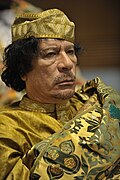Brotherly Leader and Guide of the Revolution
| Brotherly Leader and Guide of the Revolution الشقيق القائد ومرشد الثورة |
|
|---|---|

|
|
| Style | His Excellency |
| Residence | Bab al-Azizia, Tripoli |
| Formation | 2 March 1979 |
| First holder | Muammar Gaddafi |
| Final holder | Muammar Gaddafi |
| Abolished | 20 October 2011 |
The Brotherly Leader and Guide of the Revolution (Arabic: الشقيق القائد ومرشد الثورة) was an unofficial title held by former Libyan leader Muammar Gaddafi, who claimed to be merely a symbolic figurehead of the country's official governance structure. However, critics have long described him as a demagogue, referring to his position as the de jure former political office, despite the Libyan state's denial of him holding any power.
After the coup d'état on 1 September 1969, in which King Idris I was deposed, Libya was governed by the Revolutionary Command Council (RCC) headed by Gaddafi. On 2 March 1977, after the adoption of the Declaration on the Establishment of the Authority of the People, the RCC was abolished and the supreme power passed into the hands of the General People's Congress. Gaddafi then became Secretary-General of the General People's Congress.
On 2 March 1979, Gaddafi renounced all public functions and was designated the "Leader" (Qāʾid) of the Libyan state and was accorded the honorifics "Guide of the First of September Great Revolution of the Socialist People's Libyan Arab Jamahiriya" or "Brotherly Leader and Guide of the Revolution" in government statements and the official press.
Although this title was officially used only from 1979, it is often applied for the whole period of Gaddafi's rule. Although Gaddafi had no official government function from 1979, it was understood that he exercised near-absolute control over the government and the country. His 42 years in power prior to the civil war in 2011 have made him the fifth longest-ruling non-royal national leader since 1900, as well as the longest-ruling Arab leader.
...
Wikipedia

